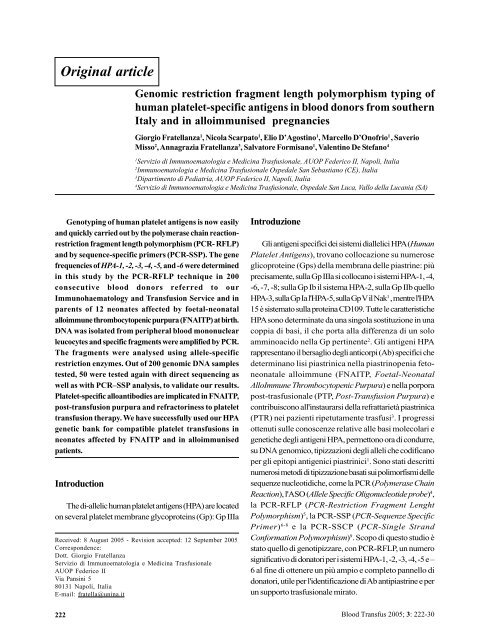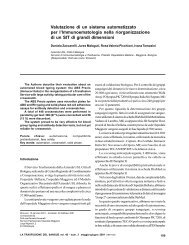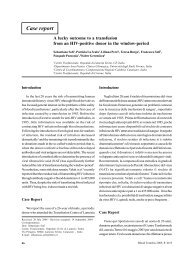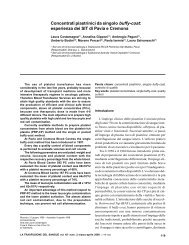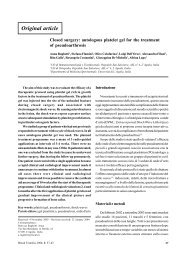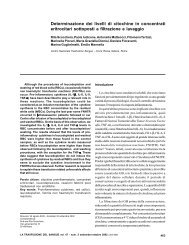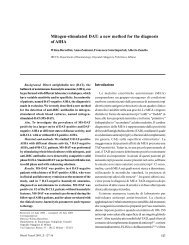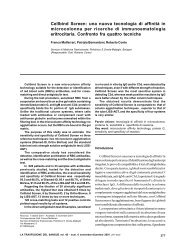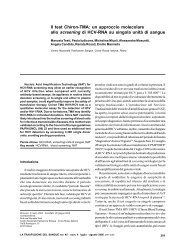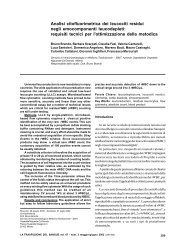Original article - Blood Transfusion
Original article - Blood Transfusion
Original article - Blood Transfusion
You also want an ePaper? Increase the reach of your titles
YUMPU automatically turns print PDFs into web optimized ePapers that Google loves.
G Fratellanza et al.Table I - Sequences of the specific primers used for PCR and their genomic position on DNAPrimerSequence DNAHPA-1(s) 5’-CTGCAGGAGGTAGAGAGTCGCCATAG-3’ 12447HPA-1(a) 5’-GTGCAATCCTCTGGGACTGACTTG-3’ 12923HPA-2(s) 5’-CCTTCAACCGGCTGACCTCGCTGCC-3’ 3083HPA-2(a) 5’-TTCAGCATTGTCCTGCAGCCAGC-3’ 3685HPA-3(s) 5’-CTCAAGGTAAGAGCTGTGAAGAAGAC-3’ 13834HPA-3(a) 5’-CTCACTACGAGAAGGATCCTGAACCTC-3’ 14281HPA-4(s) 5’-TACCAAGCTGGCCACCCAGATT-3’ 13842HPA-4(a) 5’-CCAAACAGGGAGACCAAGGTAGAA-3’ 14047HPA-5(s) 5’-GTGACCTAAAGAAAGAGG-3’ 1601HPA-5(a) 5’-CTCTCATGGAAAATGGCAG-3’ 1874HPA- 6 (s) 5’- CTGGCTGGCTGGGATCCCAGTG- 3’HPA- 6 (a) 5’- CCCTGCAGTTCTCCTCACCTGAG- 3’Table II - PCR protocol: master mixMaster mix HPA-1 HPA-2 HPA-3 HPA-4 HPA-5 HPA-6Buffer 2µL 2µL 2µL 2µL 2µL 2µLW1(5%) 1µL 1µL 1µL 1µL 1µL 1µLDNTPs (10µM) 0.8µL 0.8µL 0.8µL 0.8µL 0.8µL 0.8µLForward 1µL 1µL 1µL 1µL 0.8µL 0.8µLReverse 1µL 1µL 1µL 1µL 0.8µL 0.8µLMgCl 20.6µL 0.4µL 0.4µL 0.4µL 0.4µL 0.4µLTAQ 0.08µL 0.08µL 0.08µL 0.08µL 0.08µL 0.08µLH 20 13.52µL 13.72µL 13.72µL 13.72µL 14.12µL 14.12µLTable III - PCR protocol: amplification cycles (temperature, time, number of cycles)Cycles HPA-1 HPA-2 HPA-3 HPA-4 HPA-5 HPA-6Denaturation 95 °C x 5’(1) 95 °C x 5’(1) 95 °C x 5’(1) 95 °C x 5’(1) 95 °C x 5’(1) 95 °C x 5’(1)Denaturation 95 °C x 30’’(30) 95 °C x 1’(35) 95 °C x 1’(35) 95 °C x 1’(30) 95 °C x 55’’(36) 95 °C x 1’ (28)Annealing 62 °C x 15’’(30) 68 °C x 1’(35) 60 °C x 1’(35) 60 °C x 30’’(30) 51 °C x 55’’(36) 70 °C x 1’ (28)Extension 72 °C x120’’(30) 72 °C x 1’(35) 72 °C x 1’(35) 72 °C x 30’’(30) 72 °C x 30’’(36) 72 °C x 1’ (28)End cycle 72 °C x5’ 72 °C x5’ 72 °C x5’ 72 °C x 5’ 72 °C x 5’ 72 °C x 5’Table IV - Restriction-enzymes used to digest the amplification products and restriction sequencesAlloantigens Genes Site on cDNA Aa. Restriction sequences Enzyme Undigested amplificate Alleles (bp)HPA-1 a GPIIIa 196: CTG 33:Leu CTGGG Nci I 247 247HPA-1 b CCG Pro CCGGG 77/170HPA-2 a GPIb 524: ACG 145:Thr GACGTC BsaH I 353 111/242HPA-2 b ATG Met GATGTC 353HPA-3 a GPIIb 2622:ATC 843:Ile CATCC Fok I 253 126/127HPA-3 b AGC Ser CAGCC 253HPA-4 a GPIIIa 526: CGA 143:Arg TCGA Taq I 276 22/92/162HPA-4 b CAA Gln TCAA 114/162HPA-5 a GPIa 1648:GAG 505:Glu GAGG Mnl I 274 8/33/136/97HPA-5 b AAG Lys AAGG 8/169/97HPA-6 a GPIIIa 1564: CAG 489: Gln CGGA Mwa I 240 240HPA-6 b CGG Arg CAGG 75/165224<strong>Blood</strong> Transfus 2005; 3: 222-30
HPA genotyping in southern ItalyHPA-1: Nci I (1U) 37°C over night → HPA-1a: 247bpHPA-1b: 77+170bpHPA-1aHPA-1b247bp↓Nci 1↓CTGGG247bp77bp CCGGG 170bp↑Nci 1HPA-3: Fok I (1U) 37°C over night → HPA-3a: 126+127 bpHPA-3b: 253 bpHPA-3aHPA-3b253bp↓Fok 1↓126bp CATCC 127bp↑Fok I253bpCAGCCHPA-5: Mnl I (1U) 37°C over night → HPA 5a: 8+33+136+97 bpHPA 5b: 8+169+97 bpHPA-5aHPA-5b274bp↓Mnl 1↓8bp 33bp 136bp GAGG 97bp↑ ↑ ↑Mnl I Mnl I Mnl I8bp 169bp AAGG 97bp↑↑Mnl IMnl IFigure 1 - Diagrammatic representation of the restriction site map of the PCR amplified fragments of HPA-1, HPA-3, HPA-5 generatedafter digestion. The arrows indicate the positions of the restriction enzyme sitestable I. PCR was performed according to the protocolsummarised in tables II and III. The position of the enzymerestriction sites on the bp PCR product and the length ofthe fragment generated after digestion by Nci I (HPA-1),Fok I (HPA-3) and Mnl I (HPA- 5) are schematically shownin figure 1. After amplification, the PCR products weredigested with restriction enzymes under the conditionssummarised in table IV. The restriction products weresubmitted to gel electrophoresis in a 3% agarose gel for120’ at 100-150 Volt in TAE buffer. DNA fragments wereresponsabile delle gravi forme di FNAITP osservate nei 12neonati ed è stata confermata dalla presenza di anticorpilesivi nel siero materno (10 anti-HPA-1a e 2 anti-HPA-1b).La figura 2 mostra un esempio delle analisi PCR-SSPper i 6 sistemi HPA indagati.DiscussioneCiascun sistema HPA consiste di 2 varianti alleliche,<strong>Blood</strong> Transfus 2005; 3: 222-30225
G Fratellanza et al.Table V - HPA genotype and antigens frequencies in the studied populationHPA Genotype Number of subjects Genotype Frequencies (%) HPA Antigens Antigen Frequency (%)Gene FrequencyHPA-1 a/a 144 72% HPA-1 a 95.5% 0.838HPA-1 a/b 47 23.5%HPA-1 b/b 9 4.5% HPA-1 b" 28% 0.162HPA-2 a/a 146 73% HPA-2 a 97% 0.850HPA-2 a/b 48 24%HPA-2 b/b 6 3% HPA-2 b 26.5% 0.150HPA-3 a/a 92 46% HPA-3 a 85.5% 0.658HPA-3 a/b 79 39.5%HPA-3 b/b 29 14.5% HPA-3 b 54% 0.342HPA-4 a/a 199 99.5% HPA-4 a 100% 0.998HPA-4 a/b 1 0.5%HPA-4 b/b 0 0% HPA-4 b 0.5% 0.002HPA-5 a/a 169 84.5% HPA-5 a 99.5% 0.920HPA-5 a/b 30 15%HPA-5 b/b 1 0.5% HPA-5 b 15.5% 0.080HPA-6 a/a 199 99.5% HPA-6 a 100% 0.998HPA-6 a/b 1 0.5%HPA-6 b/b 0 0% HPA-6 b 0.5% 0.002Figure 2 - PCR-SSP agarose gel determination of HPA polymorphisms in six donors226<strong>Blood</strong> Transfus 2005; 3: 222-30
HPA genotyping in southern ItalyTable VI - Comparison of the frequency of HPA antigens in Caucasian populations and other populationsHPA antigens Studied subjects Dutch USA Finn Japanese(Italians) population 11 white population 12 population 13 population 14,151a 95.5% 97.9% 98% 99% 100%1b 28% 28.8% 20% 26.5% 0.3%2a 97% 100% 97% 99% 99.2%2b 26.5% 13.2% 15% 16.5% 19.7%3a 85.5% 81% 88% 83.5% 85.1%3b 54% 69.8% 54% 66.5% 66.2%4a 100% 100% 100% 100% -4b 0.5% 1% 1% 1% -5a 99.5% 100% 98% 99.5% 99.0%5b 15.5% 19.7% 21% 10% 7.0%6a 100% - - 100% 99.7%6b 0.5% - - < 1% 5.13%visualised horizontally using a molecular weight marker toenable evaluation of the results. The detection of DNAfragments was carried under UV light.The PCR-SSP analysis was performed according to theworking protocol of Domino Protrans HPA System (NuclearLaser, Settala, MI, Italy).Out of 200 genomic DNA donor samples tested, 50 wereexamined again with a direct sequencing as well as PCR–SSP analysis, to validate our results.ResultsGenotypic and antigenic frequencies of HPA-1, -2, -3, -4, -5, -6 in the analysed samples from blood donors aresummarised in table V. Our results from 12 couples of parentsof neonates born with a severe form of FNAITP showedincompatibility only for HPA-1 system. Theseincompatibilities were responsible for the FNAITP andconfirmed by the presence of offending antibodies inmaternal serum (10 anti-HPA-1a, 2 anti-HPA-1b).Figure 2 shows a diagrammatic example of PCR-SSPanalysis of the HPA 1-6 systems.DiscussionEach HPA system consists of two allelic variants, nowknown as “a”, high frequency, and “b”, low frequency.These allelic variants are caused by single point mutations,which result in single amino acid changes between the twodifferent gene products.In our study the frequencies of the alleles in most ofthe HPA systems are comparable to those described byother authors for the European Caucasian population 11 . Inconosciute, rispettivamente, come "a", ad alta frequenza, e"b", a bassa frequenza. Le varianti sono causate da unasola mutazione puntiforme che determina un cambiamentoin un singolo amminoacido in due diversi prodotti genici.Le frequenze per i più importanti sistemi HPA, ottenute nelnostro studio, sono paragonabili a quelle trovate da altriAutori nei caucasici europei 11 . Al contrario, la frequenzadell'antigene HPA-1b è più alta nel nostro campione rispettoa quelle della popolazione bianca statunitense e dellapopolazione giapponese (Tabella VI) 11-15 .Tali dati avvalorano ulteriormente che la frequenza deglialleli HPA-4b e HAP-6b è, nei caucasici, molto bassa (
G Fratellanza et al.contrast, the frequency of the HPA-1b antigen in oursamples was higher than that in Japanese and white USApopulations (Table VI) 11-15 .Our data further corroborate that the frequency of theless common HPA-4b and HPA-6b alleles is extremely low(
HPA genotyping in southern Italylow number of platelets that can be collected fromthrombocytopenic patients. Reagents suitable for serologicHPA typing are rare and available only in specialisedlaboratories. Moreover, in some clinical situations, noplatelets are available for alloantigen typing, while anymaterial from which DNA can be extracted is suitable forgenotyping.ConclusionsOur results confirm that the HPA-1 polymorphism isthe one most frequently involved in FNAITP in theCaucasian population 23,24 . Furthermore, the extremely lowfrequency of HPA-4b and HPA-6b antigens implies thatthe risk of platelet transfusion refractoriness due to thesetwo alloantigenic systems is very low. The promptavailability of HPA genotyped platelets is very useful forboth diagnosis and transfusion support in patients withalloantibody-related thrombocytopenia 21 .-4, -5, -6 impiegando PCR-RFLP in 200 donatori disangue, convenuti consecutivamente al nostro ServizioTtrasfusionale e in entrambi i genitori di 12 neonati affettida FNAITP (Foetal-Neonatal AlloImmuneThrombocytopenic Purpura). Il DNA è stato isolato daleucociti del sangue periferico e i frammentio specificisono stati amplificati in PCR. L'analisi dei frammenti èstata condotta con enzimi di restrizione specifici. Perconfermare i nostri risultati, 50 dei 200 campioni testatisono stati ulteriormente esaminati in PCR-SSP. Anticorpispecificamente diretti contro antigeni HPA sonoresponsabili della FNAIP, di Porpora Post-Trasfusionakee di refrattarietà alla terapia trasfusionale conconcentrati piastrinici. Finora, abbiamo utilizzato, consuccesso, la nostra banca per trasfusioni HPA-compatibiliin neonati affetti da FNAITP o in pazienti immunizzati.<strong>Blood</strong> Transfus 2005; 3: 222-30229
G Fratellanza et al.References1) Krunicki TS, Newman PJ The molecular immunology ofhuman platelet proteins. <strong>Blood</strong> 1992; 80: 1386-404.2) Newman PJ, Derbes RS, Aster RH The human plateletalloantigens, Pl A1 and Pl A2 are associated with a leucin 33/proline 33 amino acid polymorphism in membraneglycoproteins IIIa, and are distinguishable by DNA typing. JClin Invest 1989; 83: 1778-81.3) Newman PJ, Mc Farland JG, Aster RH AlloimmuneThrombocytopenia. In: Loscalzo J, Schafer Al, editors.Thrombosis and Hemorrhage. Boston, Blackwell ScientificPublications 1994. p. 529-43.4) Mc Farlands JG, Aster RH, Bussel JB, et al. Prenataldiagnosis of neonatal alloimmune thrombocytopenia usingallele-specific oligonucleotide probes. <strong>Blood</strong> 1991; 78: 2276-82.5) Unkelbach K, Kalb R, Santoso S, et al. Genomic RFLP typingof human platelet alloantigens Zw (PlA), Ko, Bak and Br(HPA-1,2,3,5). Br J Haematol 1995; 89: 169-76.6) Metcalfe P, Waters AH. HPA 1 typing by PCR amplificationwith sequence-specific primers (PCR-SSP): a rapid andsimple technique. Br J Haematol 1993; 85: 227-9.7) Lyou JY, Chen YJ, Hu HY, et al. PCR with sequence-specificprimer-based simultaneous genotyping of human plateletantigen-1 to -13w. <strong>Transfusion</strong> 2002; 42: 1089-95.8) Jones DC, Bunce M, Fuggle SV, et al. Human plateletalloantigens (HPAs): PCR-SSP genotyping of a UKpopulation for 15 HPA alleles. Eur J Immunogenet 2003; 30:415-9.9) Fujiwara K, Tokunaga K, Wang L, et al. DNA-based typingof human platelet antigen systems by polymerase chainreaction single-strand conformation polymorphism method.Vox Sang 1995; 69: 347-51.10) Mackey K, Steinkamp A, Chomczynski P. DNA extractionfrom small blood volumes and the processing of celluloseblood cards for use in PCR. Mol Biotechnol 1998; 9: 1-5.11) Simsek S, Faber NM, Bleeker PM, et al. Determination ofhuman platelet antigens in the Dutch population byimmunophenotyping and DNA (allele-specific restrictionenzyme) analysis. <strong>Blood</strong> 1993; 81: 835-40.12) Kim HO, Jin Y, Kickler TS, et al. Gene frequencies of the fivemajor human platelet antigens in African American, white,and Korean populations. <strong>Transfusion</strong> 1995; 35: 863-7.13) Kekomaki S, Partanen I, Kekomaki R. Platelet alloantigenHPA 1, 2, 3, 5 and 6b in Finns. Transf Med 1995; 5: 193.14) Tanaka S, Ohnoki S, Shibata H, et al. Gene frequencies ofhuman platelet antigens on glycoprotein IIIa in Japanese.<strong>Transfusion</strong> 1996; 36: 813-7.15) Tanaka S, Tanins A, Nagan N, et al. Genotype frequencies ofthe human platelet antigen Ca/Tu in Japanese determined bya PCR-RFLP method. Vox Sang 1995; 70: 40-4.16) Riner AP, Teramura G. A modified PCR-RFLP genotypingmethod demonstrates the presence of the HPA 4b plateletalloantigen in a North American Indian population.Immunohematol 1997; 13: 37-43.17) Warkentin TE, Smith JW. The alloimmune thrombocytopenicsyndromes. Transf Med Rev 1997; 11: 296-307.18) Kiefel V, Santoso S, Weisheit M, et al. Monoclonal antibodyspecific immobilization of platelet antigens (MAIPA): a newtool for the identification of platelet reactive antibodies. <strong>Blood</strong>1987; 70: 1722-6.19) Kupatawintu P, Nathalang O, O-Charoen R, et al. Genefrequencies of the HPA-1 to 6 and Gov human plateletantigens in Thai blood donors. Immunohematol 2005; 21: 5-9.20) Rachel JM, Summers TC, Sinor LT, et al. Use of a solidphase red blood cell adherence method for pre-transfusionplatelet compatibility testing. Am J Clin Pathol 1988; 90:63-8.21) Ohto H, Miura S, Ariga H, et al. The natural history ofmaternal immunization against foetal platelet alloantigens.Transfus Med 2004; 14: 399-408.22) Breamdam S, Frepi MB, De Geey SR. Evaluation of solidphase enzyme immunoassay and comparison with the indirectimmunofluorescence. Am J Cl Pathol 1998; 109: 190-5.23) Dreyfus M, Kaplan C, Verdy E, et al. Frequency of immunethrombocytopenic in newborns: a prospective study. <strong>Blood</strong>1997; 89: 4402-6.24) Verran J, Grey D, Bennett J, et al. HPA-1,3,5 genotyping toestablish a typed platelet donor panel. Pathology 2000; 32:89-93.230<strong>Blood</strong> Transfus 2005; 3: 222-30


